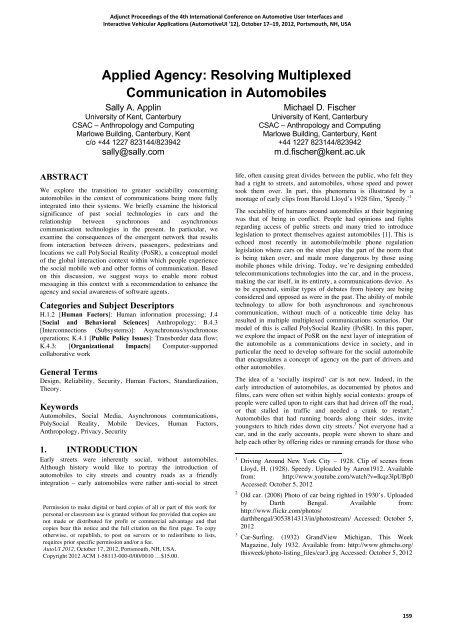12: Adjunct Proceedings - Automotive User Interfaces and ...
12: Adjunct Proceedings - Automotive User Interfaces and ...
12: Adjunct Proceedings - Automotive User Interfaces and ...
Create successful ePaper yourself
Turn your PDF publications into a flip-book with our unique Google optimized e-Paper software.
ABSTRACT<br />
<strong>Adjunct</strong> <strong>Proceedings</strong> of the 4th International Conference on <strong>Automotive</strong> <strong>User</strong> <strong>Interfaces</strong> <strong>and</strong><br />
Interactive Vehicular Applications (<strong>Automotive</strong>UI '<strong>12</strong>), October 17–19, 20<strong>12</strong>, Portsmouth, NH, USA<br />
Applied Agency: Resolving Multiplexed<br />
Communication in Automobiles<br />
Sally A. Applin<br />
University of Kent, Canterbury<br />
CSAC – Anthropology <strong>and</strong> Computing<br />
Marlowe Building, Canterbury, Kent<br />
c/o +44 <strong>12</strong>27 823144/823942<br />
sally@sally.com<br />
We explore the transition to greater sociability concerning<br />
automobiles in the context of communications being more fully<br />
integrated into their systems. We briefly examine the historical<br />
significance of past social technologies in cars <strong>and</strong> the<br />
relationship between synchronous <strong>and</strong> asynchronous<br />
communication technologies in the present. In particular, we<br />
examine the consequences of the emergent network that results<br />
from interaction between drivers, passengers, pedestrians <strong>and</strong><br />
locations we call PolySocial Reality (PoSR), a conceptual model<br />
of the global interaction context within which people experience<br />
the social mobile web <strong>and</strong> other forms of communication. Based<br />
on this discussion, we suggest ways to enable more robust<br />
messaging in this context with a recommendation to enhance the<br />
agency <strong>and</strong> social awareness of software agents.<br />
Categories <strong>and</strong> Subject Descriptors<br />
H.1.2 [Human Factors]: Human information processing; J.4<br />
[Social <strong>and</strong> Behavioral Sciences] Anthropology; B.4.3<br />
[Interconnections (Subsystems)]: Asynchronous/synchronous<br />
operations; K.4.1 [Public Policy Issues]: Transborder data flow;<br />
K.4.3: [Organizational Impacts] Computer-supported<br />
collaborative work<br />
General Terms<br />
Design, Reliability, Security, Human Factors, St<strong>and</strong>ardization,<br />
Theory.<br />
Keywords<br />
Automobiles, Social Media, Asynchronous communications,<br />
PolySocial Reality, Mobile Devices, Human Factors,<br />
Anthropology, Privacy, Security<br />
1. INTRODUCTION<br />
Early streets were inherently social, without automobiles.<br />
Although history would like to portray the introduction of<br />
automobiles to city streets <strong>and</strong> country roads as a friendly<br />
integration – early automobiles were rather anti-social to street<br />
Permission to make digital or hard copies of all or part of this work for<br />
personal or classroom use is granted without fee provided that copies are<br />
not made or distributed for profit or commercial advantage <strong>and</strong> that<br />
copies bear this notice <strong>and</strong> the full citation on the first page. To copy<br />
otherwise, or republish, to post on servers or to redistribute to lists,<br />
requires prior specific permission <strong>and</strong>/or a fee.<br />
AutoUI 20<strong>12</strong>, October 17, 20<strong>12</strong>, Portsmouth, NH, USA.<br />
Copyright 20<strong>12</strong> ACM 1-58113-000-0/00/0010 …$15.00.<br />
Michael D. Fischer<br />
University of Kent, Canterbury<br />
CSAC – Anthropology <strong>and</strong> Computing<br />
Marlowe Building, Canterbury, Kent<br />
+44 <strong>12</strong>27 823144/823942<br />
m.d.fischer@kent.ac.uk<br />
life, often causing great divides between the public, who felt they<br />
had a right to streets, <strong>and</strong> automobiles, whose speed <strong>and</strong> power<br />
took them over. In part, this phenomena is illustrated by a<br />
montage of early clips from Harold Lloyd’s 1928 film, ‘Speedy.’ 1<br />
The sociability of humans around automobiles at their beginning<br />
was that of being in conflict. People had opinions <strong>and</strong> fights<br />
regarding access of public streets <strong>and</strong> many tried to introduce<br />
legislation to protect themselves against automobiles [1]. This is<br />
echoed most recently in automobile/mobile phone regulation<br />
legislation where cars on the street play the part of the norm that<br />
is being taken over, <strong>and</strong> made more dangerous by those using<br />
mobile phones while driving. Today, we’re designing embedded<br />
telecommunications technologies into the car, <strong>and</strong> in the process,<br />
making the car itself, in its entirety, a communications device. As<br />
to be expected, similar types of debates from history are being<br />
considered <strong>and</strong> opposed as were in the past. The ability of mobile<br />
technology to allow for both asynchronous <strong>and</strong> synchronous<br />
communication, without much of a noticeable time delay has<br />
resulted in multiple multiplexed communications scenarios. Our<br />
model of this is called PolySocial Reality (PoSR). In this paper,<br />
we explore the impact of PoSR on the next layer of integration of<br />
the automobile as a communications device in society, <strong>and</strong> in<br />
particular the need to develop software for the social automobile<br />
that encapsulates a concept of agency on the part of drivers <strong>and</strong><br />
other automobiles.<br />
The idea of a ‘socially inspired’ car is not new. Indeed, in the<br />
early introduction of automobiles, as documented by photos <strong>and</strong><br />
films, cars were often set within highly social contexts: groups of<br />
people were called upon to right cars that had driven off the road,<br />
or that stalled in traffic <strong>and</strong> needed a crank to restart. 2<br />
Automobiles that had running boards along their sides, invite<br />
youngsters to hitch rides down city streets. 3 Not everyone had a<br />
car, <strong>and</strong> in the early accounts, people were shown to share <strong>and</strong><br />
help each other by offering rides or running err<strong>and</strong>s for those who<br />
1<br />
Driving Around New York City – 1928. Clip of scenes from<br />
Lloyd, H. (1928). Speedy. Uploaded by Aaron19<strong>12</strong>. Available<br />
from: http://www.youtube.com/watch?v=lkqz3lpUBp0<br />
Accessed: October 5, 20<strong>12</strong><br />
2<br />
Old car. (2008) Photo of car being righted in 1930’s. Uploaded<br />
by Darth Bengal. Available from:<br />
http://www.flickr.com/photos/<br />
darthbengal/3053814313/in/photostream/ Accessed: October 5,<br />
20<strong>12</strong><br />
3<br />
Car-Surfing. (1932) Gr<strong>and</strong>View Michigan, This Week<br />
Magazine, July 1932. Available from: http://www.ghmchs.org/<br />
thisweek/photo-listing_files/car3.jpg Accessed: October 5, 20<strong>12</strong><br />
159





